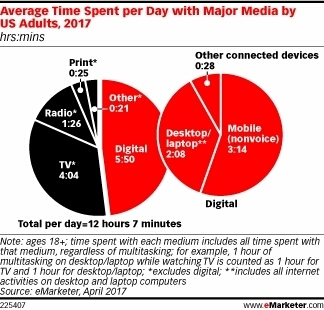 Your new post is loading...
 Your new post is loading...
Thanks to multitasking (and our method of accounting for it, explained in a moment), US adults’ average daily time spent with major media will slightly exceed 12 hours this year, according to eMarketer’s latest report, “US Time Spent with Media: eMarketer’s Updated Estimates and Forecast for 2014-2019” (available only to eMarketer PRO subscribers). But while our reports early in the decade told a story of robust gains—with increases in digital usage more than compensating for declines in time spent with non-digital media—growth has been petering out. Of course, media multitasking is what has made so much usage possible. Like a Coney Island contestant stuffing hot dogs into his mouth with both hands, people are often using multiple media at the same time....
Dear Mona, Is the express lane in the grocery store always the fastest lane? Barry, 44, New York.
...That’s what Wes Stevenson, a professional data analyst, did out of sheer curiosity. To test the difference between single and multiple lines, Stevenson quantified a few assumptions (10 cashiers, an average wait time of 3 minutes) and put them into his model to see what it would spit out.
He found that the wait time in single lines is more predictable (you can see that in the chart below, where there’s a narrower spread of outcomes). More importantly, though, Stevenson found that a single line is more likely to mean a shorter wait (also visible below, where the single-line chart clusters farther left than the multiple-line one, meaning that more of those 10,000 simulations produced a shorter wait time)....
A study released by the Acquity Group, part of Accenture Interactive, has found that 94 percent of B2B buyers conduct some research before making a purchase, with 55 percent of them doing so for at least half of their purchases.
XThe “State of B2B Procurement” report looked at 500 B2B procurement officers with annual purchasing budgets of approximately $100,000. The goal was to determine how B2B companies adapt and stay competitive through their purchasing decisions.
About 68 percent of B2B buyers purchase goods online, compared to 57 percent cited in the 2013 version of the study. Nearly 44 percent of respondents said that they researched goods and services on a smartphone or tablet over the past 12 months....
Five years ago, a team of researchers from Google announced a remarkable achievement in one of the world’s top scientific journals, Nature.
...It produces uncannily accurate results; that every single data point can be captured, making old statistical sampling techniques obsolete; that it is passé to fret about what causes what, because statistical correlation tells us what we need to know; and that scientific or statistical models aren’t needed because, to quote “The End of Theory”, a provocative essay published in Wired in 2008, “with enough data, the numbers speak for themselves.
Unfortunately, these four articles of faith are at best optimistic oversimplifications. At worst, according to David Spiegelhalter, Winton Professor of the Public Understanding of Risk at Cambridge university, they can be “complete bollocks. Absolute nonsense.”
Found data underpin the new internet economy as companies such as Google, Facebook and Amazon seek new ways to understand our lives through our data exhaust. Since Edward Snowden’s leaks about the scale and scope of US electronic surveillance it has become apparent that security services are just as fascinated with what they might learn from our data exhaust, too....
It’s certainly been awhile since my promise to post a social media statistics update every month… but better late than never right? Here are 83 awesome statistics on Social Media Marketing, B2B, Enterprise, Small Business, Blogging, Mobile, Facebook, Instagram, LinkedIn, Twitter, Google+ and Pinterest to start your 2014. STATISTICS! You love them, I love them, and here they are in all their glory...
|
Ever wish you could read the minds of your target audience? Google Consumer Surveys is the next best thing. It allows you to survey the web with a tool so precise, it predicted the 2012 U.S. presidential election. And don’t worry – it’s affordable and easy to use.
How does it work? You start the process using the simple three-step creator, which will walk you through targeting your audience. You can choose to get a representative sample of your country’s population, or target a more specific audience by age, gender, geography, and a screening question to help further narrow your audience. You also have your choice of ten different question formats, including multiple choice, star-rating, image selection and more.
So when your survey goes out into the world, where is it going, exactly? That’s your choice. You can choose to distribute your survey through Google’s network of online publishers, or via the Google Opinion Rewards mobile app....
The demographics of who's on what social network are shifting — older social networks are reaching maturity, while newer social messaging apps are gaining younger users fast.
In a new report from BI Intelligence, we unpack data from over a dozen sources to understand how social media demographics are still shifting.
Most online mentions of companies by consumers are neutral, rather than overtly positive or negative, according to a recent report from mention.
The study, which was based on an analysis of 1 billion global mentions of 200,000 companies across social networks and websites, found 75.5% of all interactions to be run-of-the-mill, such as questions about products and requests for customer service.
Of the remaining mentions, 17.6% were clearly positive and only 5.8% were clearly negative....
Technology has changed a lot in the last 30 years—even the last three! Today’s consumer is more connected than ever, thanks to the proliferation of digital devices and platforms. Content once available only via specific channels, such as print and broadcast television, can today be delivered to consumers through their multiple connected devices.
These changes are driving a media revolution and blurring traditional media definitions. In fact, Americans now own four digital devices on average, and the average U.S. consumer spends 60 hours a week consuming content across devices. In Nielsen’s Digital Consumer Report, we explore this transformation and examine how the everyday lives of consumers are now intertwined with the digital world....
...The lack of consistent correspondence between Twitter reaction and public opinion is partly a reflection of the fact that those who get news on Twitter – and particularly those who tweet news – are very different demographically from the public.
The overall reach of Twitter is modest. In the Pew Research Center’s 2012 biennial news consumption survey, just 13% of adults said they ever use Twitter or read Twitter messages; only 3% said they regularly or sometimes tweet or retweet news or news headlines on Twitter.
Twitter users are not representative of the public. Most notably, Twitter users are considerably younger than the general public and more likely to be Democrats or lean toward the Democratic Party. In the 2012 news consumption survey, half (50%) of adults who said they posted news on Twitter were younger than 30, compared with 23% of all adults. And 57% of those who posted news on Twitter were either Democrats or leaned Democratic, compared with 46% of the general public. (Another recent Pew Research Center survey provides even more detail on who uses Twitter and other social media.)...
|



 Your new post is loading...
Your new post is loading...




















US adults will spend more than half the day with major media thanks to multitasking. But will they read your next blog post?